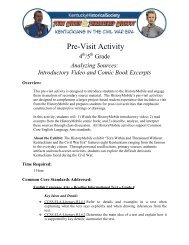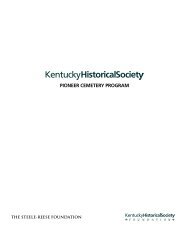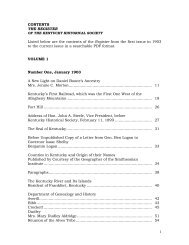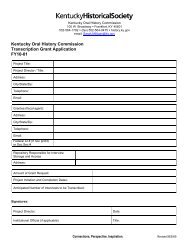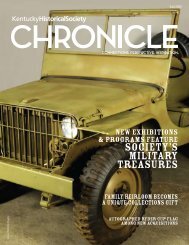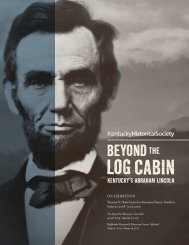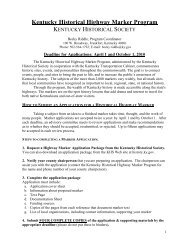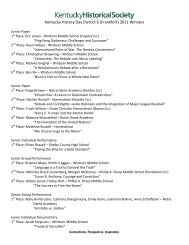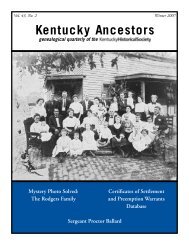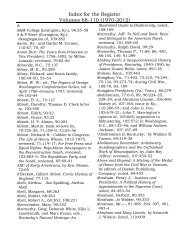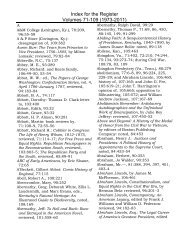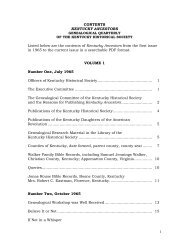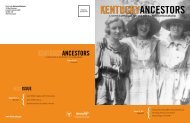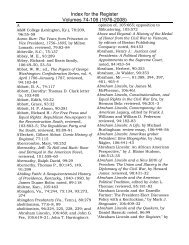Kentucky Ancestors, Volume 46, Number 3 - Kentucky Historical ...
Kentucky Ancestors, Volume 46, Number 3 - Kentucky Historical ...
Kentucky Ancestors, Volume 46, Number 3 - Kentucky Historical ...
You also want an ePaper? Increase the reach of your titles
YUMPU automatically turns print PDFs into web optimized ePapers that Google loves.
Ft. Anderson, Paducah, <strong>Kentucky</strong>. (KHS Collection)<br />
feelings about being enslaved; his secret thoughts,<br />
and perceptions. He certainly was intelligent enough<br />
to understand his situation. The metaphorical quip<br />
of a cat with nine lives aptly fits my ancestor. His<br />
resilience is symbolized by the ancestor star I wear<br />
on my Daughters of the Union Veterans badge. How<br />
did a man obtain the venerable age of ninety-eight 11<br />
years and rise above a series of personal challenges?<br />
Edmund Fauntleroy was a survivor of several slave<br />
sales, the Civil War, and recurrent illness. Doubtless,<br />
ironic tenacity and extraordinary persistence made<br />
the man. Fauntleroy was courageous, pragmatic, and<br />
chivalrous. He cared for a wife with special needs<br />
for a half-century. I noted my great-grandmother’s<br />
blindness in the 1870 U.S. census. Following<br />
emancipation, Edmund became a landowner and<br />
outlived both his wife and youngest daughter, my<br />
grandmother.<br />
<strong>Kentucky</strong> was a slave state on the border of<br />
the North and South where divided loyalties<br />
among civilians existed. The association of the<br />
commonwealth with the industrialized North and<br />
interstate slave trading in the lower South made it<br />
unwilling to sever Union ties over the question of<br />
slavery or the issue of state’s rights. Confederate<br />
occupation of Columbus, <strong>Kentucky</strong>, 3 September<br />
122 | <strong>Kentucky</strong> <strong>Ancestors</strong><br />
1861, prompted General Ulysses S. Grant to fortify<br />
the river town of Paducah at the confluence of<br />
the Ohio and Tennessee rivers on 6 September. 12<br />
Preceding the Civil War, Paducah was one of the<br />
points of departure for the southern slave trade of<br />
<strong>Kentucky</strong>. 13 To safeguard Paducah, the U.S. Army<br />
built Fort Anderson in 1861 from the Riverside<br />
Lourdes Hospital 14 under the direction of Gen.<br />
Charles F. Smith. 15 The seven-gun fortification was<br />
manned by five thousand troops, and named for<br />
Robert Anderson, the Kentuckian who defended Fort<br />
Sumter 16 when the Confederates fired the first shots<br />
of the rebellion in April. For the duration of the war,<br />
Paducah was a strategic administrative supply center<br />
and rail terminus for large numbers of troops and<br />
provisions headed to campaigns in the lower South. 17<br />
Paducah remained a stronghold of Rebel hostilities<br />
during the war. Pro-Confederate sympathies were<br />
especially high in 1864 when tensions between the<br />
civilian population and Federal troops led to the<br />
suspension of civil liberties. By securing the state<br />
for the Union, the military worked to eliminate the<br />
support for the rebellion by showing the Confederates<br />
that “their property, their comfort and their personal<br />
safety” were at stake because of their Confederate<br />
loyalties. 18



